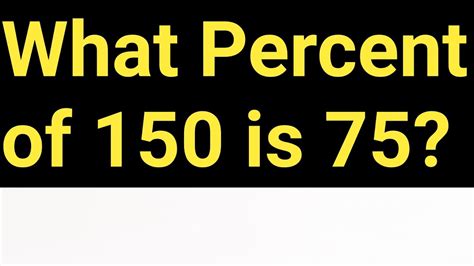75 Is What Percent Of 150
Kalali
Apr 04, 2025 · 4 min read

Table of Contents
75 is What Percent of 150? A Comprehensive Guide to Percentage Calculations
Understanding percentages is a fundamental skill in various aspects of life, from calculating discounts and taxes to analyzing data and understanding statistics. This comprehensive guide will not only answer the question, "75 is what percent of 150?" but also delve into the underlying concepts, providing you with the tools to solve similar percentage problems with confidence. We'll explore multiple approaches, from basic arithmetic to practical applications and even touch upon advanced percentage calculations.
Understanding Percentages: The Basics
A percentage is a fraction or ratio expressed as a number out of 100. The symbol "%" is used to denote percentage. Essentially, a percentage represents a portion of a whole. For example, 50% means 50 out of 100, or one-half.
The key to understanding percentages lies in grasping the relationship between the part, the whole, and the percentage itself. The formula we use is:
(Part / Whole) * 100% = Percentage
In our problem, "75 is what percent of 150?", we have:
- Part: 75
- Whole: 150
- Percentage: This is what we need to find.
Calculating "75 is What Percent of 150?"
Let's apply the formula:
(75 / 150) * 100% = Percentage
-
Divide the part by the whole: 75 / 150 = 0.5
-
Multiply the result by 100%: 0.5 * 100% = 50%
Therefore, 75 is 50% of 150.
Alternative Methods: Simplifying the Calculation
While the formula above is straightforward, we can simplify the process, especially with easily divisible numbers. Notice that 75 is half of 150. This immediately tells us the percentage is 50%. This intuitive approach is helpful for quickly solving certain percentage problems.
Another method involves using proportions:
75/150 = x/100
Cross-multiplying, we get:
150x = 7500
Dividing both sides by 150:
x = 50
Again, we find that x (our percentage) is 50%.
Practical Applications of Percentage Calculations
Percentage calculations are ubiquitous in real-world scenarios. Here are some examples:
1. Discounts and Sales
Imagine a shirt originally priced at $150 is on sale for $75. Using our knowledge, we know this represents a 50% discount. This is a crucial skill for savvy shoppers.
2. Tax Calculations
If a state has a 5% sales tax on a $150 item, the tax amount would be 5% of $150, which is (5/100) * 150 = $7.50. Understanding percentage calculations helps accurately compute the final cost.
3. Grade Calculation
Suppose you scored 75 points out of a possible 150 points on a test. Your percentage score is 50%, calculated as (75/150) * 100% = 50%.
4. Data Analysis and Statistics
Percentages are essential in representing data proportions. For instance, if a survey shows 75 out of 150 respondents prefer a certain product, it indicates a 50% preference rate.
5. Financial Calculations
Interest rates, investment returns, and loan calculations frequently involve percentage calculations. Understanding these calculations is vital for making informed financial decisions.
Beyond the Basics: More Complex Percentage Problems
While the "75 is what percent of 150?" problem is relatively simple, many percentage problems are more complex. Let's explore some variations:
1. Finding the Whole
Suppose we know that 50% of a number is 75. How do we find the whole number?
We can set up the equation:
0.5 * x = 75
Solving for x:
x = 75 / 0.5 = 150
This confirms our initial problem.
2. Finding the Part
If we know that a certain item costs $150, and there's a 20% discount, how much is the discount?
The discount amount is 20% of $150:
(20/100) * 150 = $30
The discounted price would be $150 - $30 = $120
3. Percentage Increase or Decrease
Suppose a value increases from 75 to 150. What is the percentage increase?
-
Find the difference: 150 - 75 = 75
-
Divide the difference by the original value: 75 / 75 = 1
-
Multiply by 100% to express as a percentage: 1 * 100% = 100%
The value increased by 100%.
Conversely, if the value decreased from 150 to 75, the percentage decrease would also be 100%.
Tips for Mastering Percentage Calculations
- Practice Regularly: Consistent practice is key to mastering any mathematical concept. Solve various percentage problems to build your confidence.
- Understand the Formula: A strong grasp of the basic percentage formula is essential for tackling more complex problems.
- Use Calculators Wisely: Calculators are helpful for complex calculations, but it's still important to understand the underlying principles.
- Break Down Complex Problems: Divide complex percentage problems into smaller, manageable steps.
- Check Your Work: Always double-check your calculations to ensure accuracy.
Conclusion: Percentages in Everyday Life
The ability to calculate percentages is a valuable skill applicable to numerous aspects of daily life. From calculating discounts and taxes to understanding data and making informed financial decisions, mastering percentage calculations empowers you to navigate the numerical world with greater confidence and efficiency. Understanding the fundamental concepts and practicing regularly will significantly improve your skills in this essential area of mathematics. Remember, the seemingly simple question, "75 is what percent of 150?" opens a door to a broader understanding of percentages and their widespread applications.
Latest Posts
Latest Posts
-
Cuantas Onzas De Agua Tiene Un Litro
Apr 04, 2025
-
What Percent Of 16 Is 12
Apr 04, 2025
-
What Percent Is 40 Out Of 50
Apr 04, 2025
-
What Is 185 Celsius In Fahrenheit
Apr 04, 2025
-
How Many Miles In 10 Kilometers
Apr 04, 2025
Related Post
Thank you for visiting our website which covers about 75 Is What Percent Of 150 . We hope the information provided has been useful to you. Feel free to contact us if you have any questions or need further assistance. See you next time and don't miss to bookmark.
